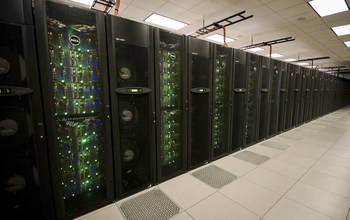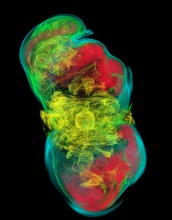All Images
News Release 16-063
Stampede 2 drives frontiers of science and engineering forward
NSF award to UT Austin builds on success of Stampede supercomputer system and provides additional advanced computational capacity to thousands of researchers
This material is available primarily for archival purposes. Telephone numbers or other contact information may be out of date; please see current contact information at media contacts.

Texas Advanced Computing Center will acquire and deploy a new large-scale supercomputing system. Here, a photograph of the original Stampede system.
Credit: Sean Cunningham, Texas Advanced Computing Center
Download the high-resolution JPG version of the image. (348.8 KB)
Use your mouse to right-click (Mac users may need to Ctrl-click) the link above and choose the option that will save the file or target to your computer.

Volume rendering of the entropy in a full 3-D GRMHD simulation of a differentially rotating and highly magnetized progenitor to a supernova. Red colors indicate high entropy (hot) material while blue represents low entropy (cold) material. Strongly magnetized material is continously launched from the surface of the proto-neutron star in the center but gets severly distorted such that, instead of a clean jet observed in the ultrastrong magnetic field case, two giant polar lobes are formed. The box size for the visualization is 2000km cubed. GRMHD refers to a general relativistic magentohydronamic simulation.
Credit: Philipp Moesta, TAPIR, California Institute of Technology
Download the high-resolution PNG version of the image. (606.1 KB)
Use your mouse to right-click (Mac users may need to Ctrl-click) the link above and choose the option that will save the file or target to your computer.

Peering into a colloidal gel, from the research group of Roseanna N. Zia, Cornell University. Dynamic simulation of the structural evolution of 750,000 attractive hard spheres.
Credit: Roseanna N. Zia, Cornell University
Download the high-resolution JPG version of the image. (1.7 MB)
Use your mouse to right-click (Mac users may need to Ctrl-click) the link above and choose the option that will save the file or target to your computer.


